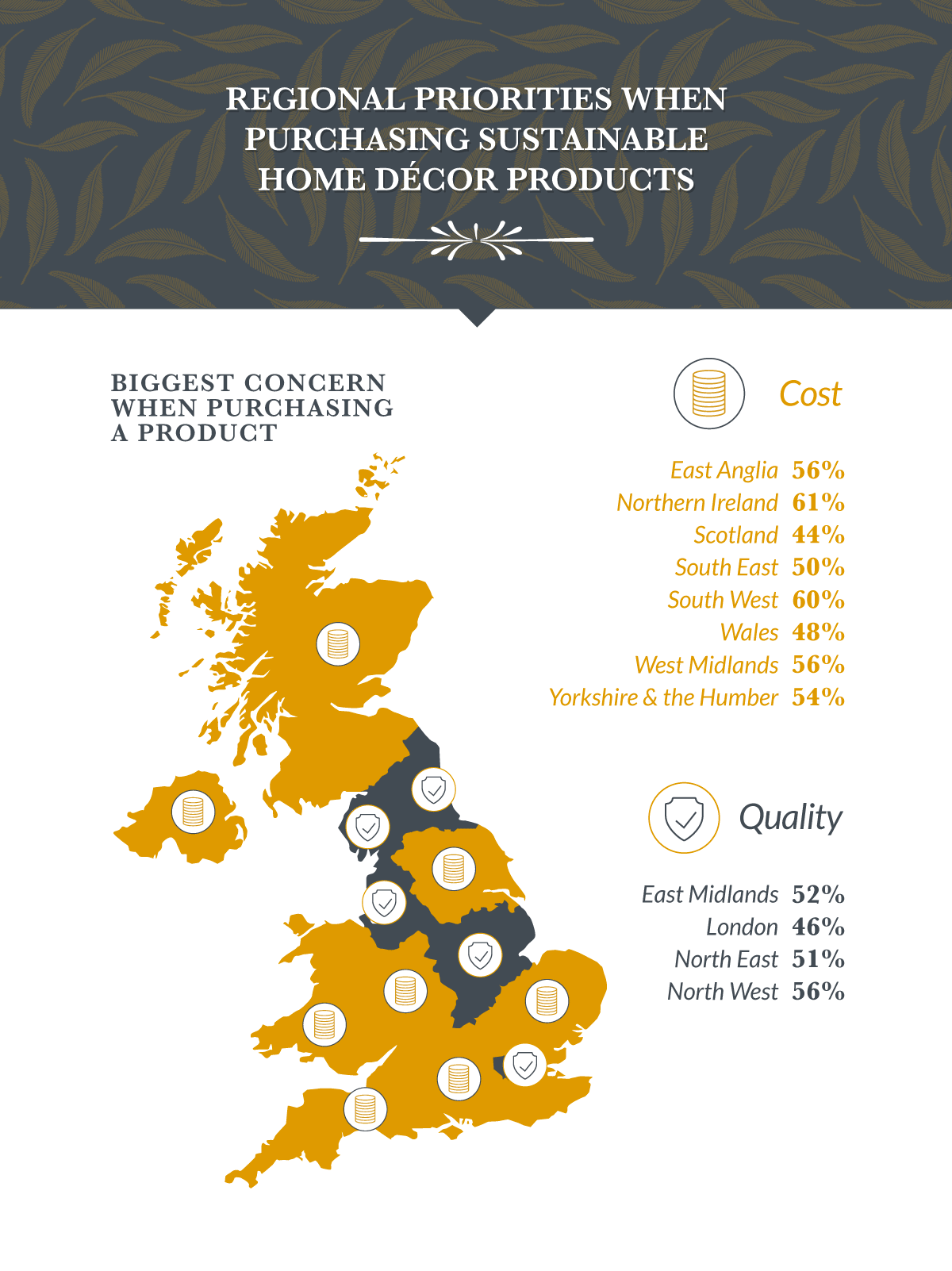The Great Green Sustainability Survey

Blinds Direct
Sustainability Survey
For good reason, the state of the global environment is increasingly playing on our minds, but what are we doing about it ourselves? Many of us are cycling and walking instead of driving, some have given up meat, and others are buying locally; but what can we do with our homes to make them greener?
To learn more about how UK homeowners are reducing their home’s impact upon the environment, we held a survey to find out who’s taking on the challenge and why others might be shying away from it.
The results are broadly positive. From installing energy-saving light bulbs to purchasing wooden blinds made from responsibly sourced woods, UK homeowners are increasingly playing their part in reducing their environmental footprint.
But how and why have our attitudes towards sustainable home products changed, and which materials are we the most conscious of?
Our survey of 2,000 UK homeowners uncovers the nation’s attitudes towards green thinking when purchasing items for the home, and how our perception of eco-friendly products has changed over the past five years.
Shifts In Attitudes Towards Sustainability

For many of us, the increased focus on climate change and the environment in the media and academia, has led to us changing our purchasing habits and reducing our impact. With more than a third (38%) of homeowners more receptive to purchasing sustainable home décor products than five years ago, the curve is certainly moving in the right direction.
That said, a key finding from the survey was that receptiveness to buying sustainable home products differs between age groups.
Younger homeowners - those aged 18-24 - account for the highest increase in receptiveness towards choosing eco-friendly décor alternatives. While this willingness decreases throughout today’s older demographics, it’s encouraging to see that there’s still been a notable 29% increase in receptiveness even among those aged 64+.
This is interesting given that younger homeowners have, on average, less disposable income than other demographics, yet still opt for sometimes costlier eco-friendly options. This suggests that, regardless of budget or circumstance, there’s often a sincere willingness to make changes, be they small or significant, to reduce one’s environmental footprint
Sylvia James, Interior Designer from Home How, says: “Today’s young homeowners are more environmentally aware than previous generations. Climate change is now normalised for them, as a key part of the curriculum. Older generations may be more sceptical about climate concerns as a result of this unfamiliarity, with different purchasing priorities. Forward-thinking retailers should be - and many are - taking it upon themselves to educate buyers about why they are offering more sustainable options.”
With more retailers hopefully making the shift to offering affordable yet stylish eco-friendly products, it’s encouraging to see that there is a notable shift in receptiveness in purchasing them across all demographics and regions. With those aged 18-24 leading the way, it’s likely this focus on the environment will continue to increase as the younger generations age.
Sustainable Purchasing Priorities

Like any creative decision, homeowners will have their own priorities when considering purchasing a sustainable home décor product. This was evident from the survey, which found the most important factors among homeowners when it comes to buying an item were cost (51%), quality (49%), and whether it could help lower bills (36%).

Those aged 55-64 accounted for the highest proportion (57%) of homeowners who prioritise the cost of a product before purchasing, while most younger homeowners (18-24) are most concerned with whether buying an item would show support for a cause or charity (57%)[2] . Older generations had this lower in their list of priorities, as 12% of those aged 64+ also deemed supporting a charity or cause as an important factor.
When it comes to energy saving and lowering bills - a key concern for many as we head into winter - younger homeowners (18-24) are the age group that cares the most (42%), which makes sense given that they’re more likely to be on a lower income and therefore most interested in cutting costs.
Meanwhile, on a regional level, the North East is most concerned (44%) with lowering energy or water bills, and London (35%) is the region which most prioritises thermal efficiency.
This is an understandable priority for many, given that research indicates 35% of heat escapes from a building via the walls, and gaps in or around windows and doors. Not only is this heat loss detrimental to comfort - it also means homeowners waste money trying to keep their home warm, impacting the environment as a result. To learn more about keeping your space comfy and warm, read our Curtains with Thermal Lining – Here’s How They Work blog.
The Environmental Impact of Materials

The materials used to craft a home furnishing play a key role in its environmental impact - particularly those featuring plastic, wood and leather. They should be carefully considered by homeowners before they make a purchase.
Fortunately, this appears to be moving in the right direction, at least for some materials. The survey found that homeowners are most conscious of evaluating the environmental impact of plastic (37%) and wood (31%) before purchasing.
Younger homeowners (those aged 18-24) make up the largest proportion (50%) of those concerned with the sustainability of a wood product, as well as the impact of leather (52%). Meanwhile, on a regional level, it’s London homeowners that care the most (24%) about sustainable wood.
Darren Green, Managing Director, commented on the importance of using responsibly-sourced wood, saying: “Making items from wood isn’t automatically bad for the environment. By ensuring our products are made with wood sourced from responsibly-managed forests plays we can help to minimise the impact of deforestation and negative impact upon communities and wildlife.
“This also works to change society’s attitude towards sustainable materials on the whole. By making responsibly-sourced products more accessible and affordable – without compromising on style - means it’s easier for consumers to make eco-friendly choices and then enjoy them at home.”
Less sustainably sourced wood is that which is not FSC (Forest Stewardship Council) approved. This means it doesn’t meet the highest environmental standards when harvested and is often sourced through harmful practices.
Sylvia James weighs in on the versatility of eco-friendly alternatives, saying: “When it comes to aesthetics, many people choose home decor that works with the lighting, colour scheme and design of their home. Natural materials such as bamboo and cork are an increasingly attractive option because of their soft and versatile aesthetic.
“Bamboo and cork grow quickly and, in the case of cork, can be harvested without damaging the tree. And when paired with the sharp lines and crisp curves that can be achieved with modern manufacturing, these easily shapeable and readily available materials will continue to grow in popularity and therefore accessibility.”
More retailers are making the move to providing inexpensive and attractive products that utilise eco-friendly materials, to make purchasing these items an easier decision for shoppers.
A greener future ahead
The study says it all - making sustainable changes to our homes is not only becoming more mainstream, but more accessible too. Eco-friendly home décor products are being created in greater numbers to suit all styles, which in turn will see more homeowners’ attitudes continue to shift towards purchasing them.
To learn more about the steps you can take to introduce a clean green dynamic into your home, read our Sustainable Design: How to Make Your Home Eco-Friendly blog.
The survey involved 2,000 UK homeowners and ran between 24/8/2021-26/8/2021/Results were split by the following demographics: age and region.
Can't Find What You're Looking For?
Call or send us an email and a member of our Customer Service team will be happy to help.
We're open:
Mon - Thu
8:30am - 9:30pm (live chat only from 6pm)
Fri
8:30am - 6pm
Sat - Sun
10am - 4pm (live chat only)
Please note, we are closed on bank holidays







